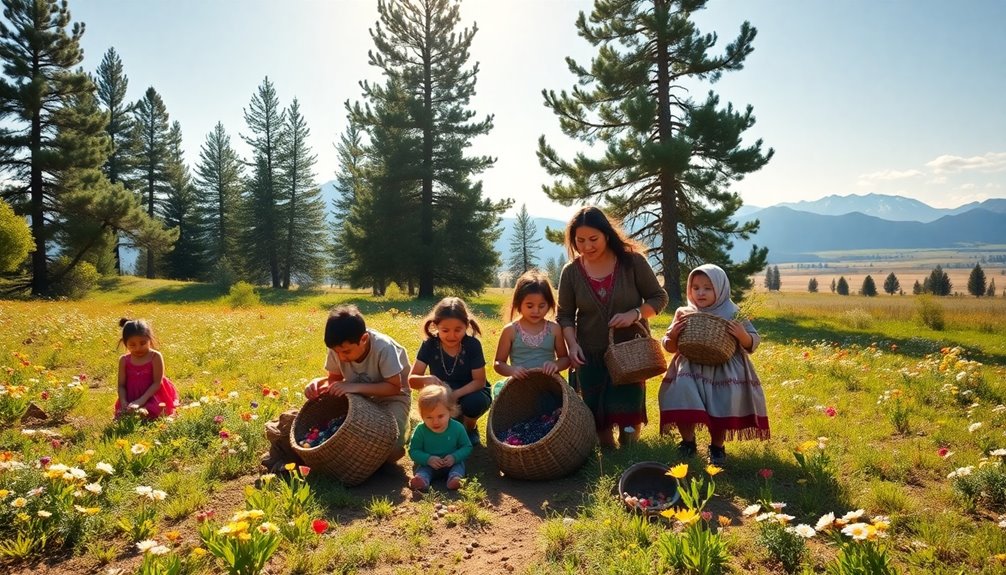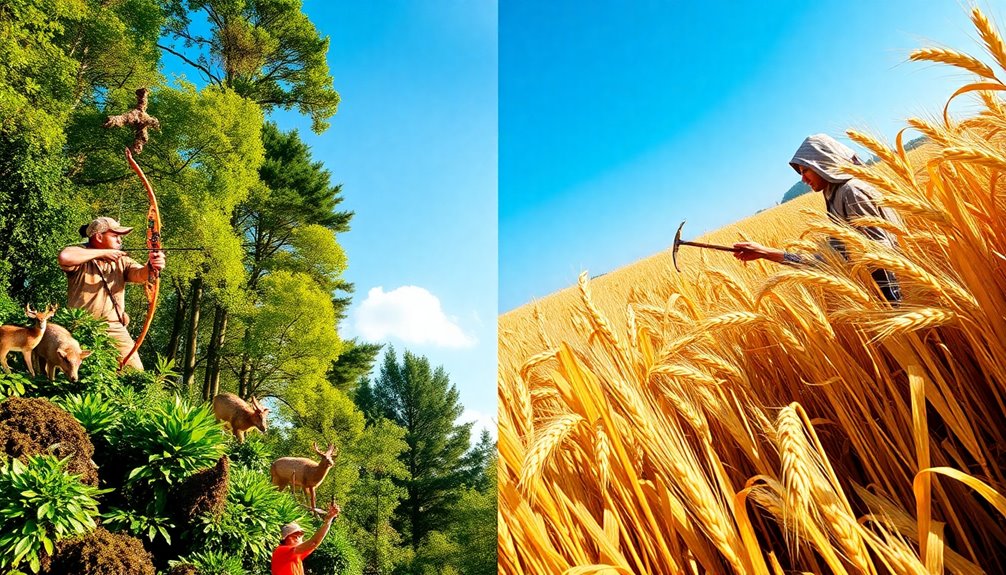Foraging societies like the Shoshone emphasize their connection to nature and community. You'll find they depend on hunting, gathering, and fishing for food. Their nomadic lifestyle allows them to move seasonally, ensuring resource availability. Socially, they're often egalitarian, with strong kinship bonds promoting cooperation. Practices like resource sharing reinforce community ties and stability. Shoshone people adapt their subsistence strategies based on the local ecosystem, showcasing resilience and environmental respect. Their interconnected rituals and beliefs further enrich their cultural identity. If you're curious, there's much more to discover about these fascinating traits and their implications.
Key Takeaways
- Foraging societies like the Shoshone rely on hunting, gathering, and fishing for their subsistence, showcasing diverse food sources.
- They maintain a nomadic lifestyle, migrating seasonally to access resources aligned with food availability.
- Social organization is typically egalitarian, with minimal hierarchy and collective decision-making fostering cooperation within the community.
- Kinship structures are flexible, promoting collaboration and strong family bonds through extended family groups.
- Cultural practices emphasize respect for nature, spirituality, and seasonal celebrations that reinforce community identity and ecological knowledge.
Overview of Foraging Societies

Foraging societies, like the Shoshone, embody a lifestyle that revolves around the rhythms of nature. You'll find that these communities rely on hunting, gathering, and fishing for subsistence, utilizing seasonal resources that their environment offers.
Their small, mobile groups frequently move to follow food sources, showcasing a nomadic lifestyle that adapts to the availability of resources.
In terms of social organization, foraging societies are often egalitarian. There's minimal social hierarchy, and decisions are typically made collectively through consensus, fostering a strong sense of community.
This structure allows everyone to contribute their knowledge and skills, which is vital for survival.
You might be surprised at the depth of understanding these foragers have of their local ecosystems. They maintain a rich knowledge of plant and animal behaviors, which informs their survival strategies and resource management.
Cultural expressions, such as storytelling and art, reflect their strong relationship with nature and serve to transmit essential knowledge and traditions across generations.
In this way, foraging societies like the Shoshone illustrate a profound connection between humans and the natural world, emphasizing the importance of cooperation and shared knowledge.
The Shoshone Cultural Context

To understand the Shoshone cultural context, you need to look at their unique subsistence strategies, social organization, and rich cultural beliefs.
They skillfully adapt to their environment through seasonal migrations and communal foraging, while their flexible kinship structure strengthens family bonds.
Additionally, their spiritual connection to the land shapes their practices and rituals, reflecting a deep respect for nature.
Shoshone Subsistence Strategies
How did the Shoshone adapt to the diverse environments of the Great Basin? They developed a versatile foraging strategy that allowed them to gather wild plants, hunt small game, and fish, guaranteeing their subsistence needs were met throughout the year.
Seasonal migrations played a key role in this adaptation, as groups moved between ecological zones to take advantage of different resources like roots, berries, and various game animals.
To thrive in these shifting environments, the Shoshone utilized a range of tools. Digging sticks helped them gather roots, while nets were perfect for fishing, and bows and arrows proved effective for hunting.
This toolkit showcased their ability to adapt to local conditions and resource availability.
The Shoshone's communal lifestyle further enriched their subsistence strategies. Decisions about resource use and migration were made collectively, emphasizing their egalitarian social structure.
This cooperative approach not only strengthened community bonds but also guaranteed that everyone contributed to and benefited from the gathered resources.
The Shoshone's deep connection to the land, viewed as sacred, reinforced their commitment to sustainable foraging practices, making their subsistence strategies essential to their identity and survival.
Social Organization and Kinship
Kinship serves as the backbone of Shoshone social organization, fostering a strong sense of community and collaboration. In this society, family groups often consist of extended relatives who work together in foraging and resource gathering.
You'll notice that social roles are fluid, allowing individuals to take on responsibilities based on age, gender, and personal skills, rather than adhering to rigid hierarchies.
The Shoshone practice a bilateral kinship system, recognizing both maternal and paternal relatives. This approach creates a broad network of social alliances, which enhances cooperation among families.
When it comes to marriage, negotiations between families help to forge ties that benefit the entire community, allowing for better resource sharing.
Gift-giving and sharing are fundamental practices, reinforcing social bonds and ensuring mutual support among kinship groups, especially during times of scarcity.
This emphasis on cooperation strengthens the community, making it more resilient against challenges. Through these practices, the Shoshone illustrate how social organization and kinship not only define their cultural identity but also support their survival in a foraging society.
Cultural Practices and Beliefs
Cultural practices and beliefs among the Shoshone are deeply intertwined with their environment and way of life. Their subsistence relies on a foraging lifestyle, where hunting, fishing, and gathering wild plants like berries and roots are essential. This connection to the land fosters a strong relationship with nature, shaping their spiritual beliefs.
You'll find that rituals and cultural practices often revolve around the natural world, reflecting the Shoshone's view of animals, plants, and the land as interconnected with their identity.
The Shoshone's seasonal mobility showcases their adaptability, as they move across mountains, plains, and deserts to access different resources throughout the year. Their social organization emphasizes community cooperation, with decision-making often conducted collectively rather than through hierarchical structures.
This egalitarian approach strengthens social bonds, ensuring everyone contributes to their shared subsistence.
In essence, the Shoshone culture thrives on a profound respect for the environment, rooted in spiritual beliefs and communal living. Their practices highlight the importance of cooperation and a deep understanding of their surroundings, ensuring their way of life persists across generations.
Hunting and Gathering Practices
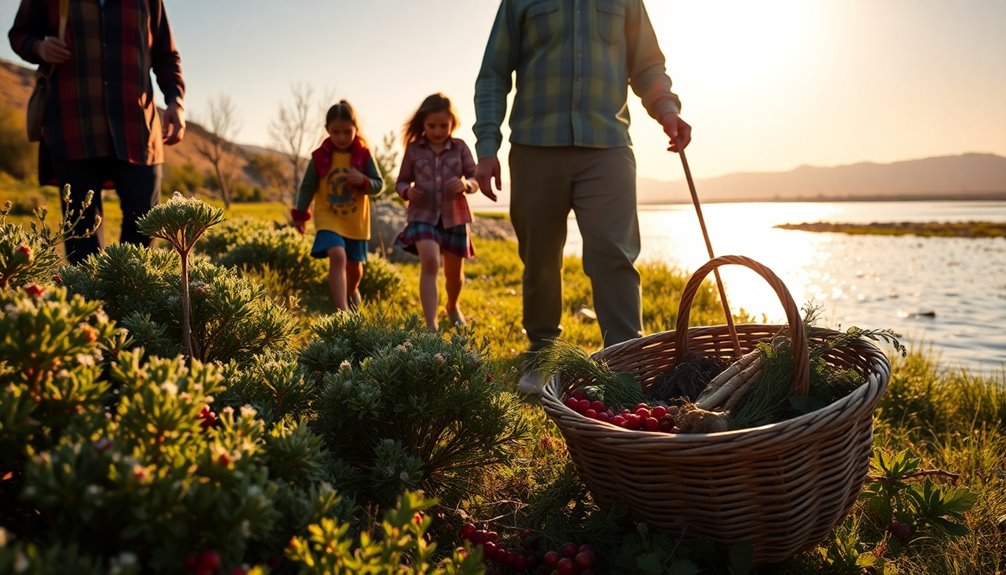
Hunting and gathering practices form the backbone of the Shoshone people's lifestyle, showcasing their deep connection to the land. They relied on a diverse diet, which included small game, fish, and a variety of wild plants. To thrive, they practiced seasonal migration, moving between ecological zones as food sources became available. This adaptability is key to their survival.
Here are some essential aspects of Shoshone hunting and gathering:
- Diverse Diet: They consumed small game, fish, roots, berries, and nuts.
- Seasonal Migration: They moved strategically to access abundant food at different times of the year.
- Environmental Knowledge: The Shoshone used natural cues to track animal movements and plant ripening.
- Social Organization: Small, flexible bands facilitated cooperation in hunting and gathering, allowing them to share resources effectively.
Their tools and technologies, such as bows, arrows, and digging sticks, reflect their deep understanding of the diverse landscapes they inhabited.
Social Structure and Leadership

The Shoshone people's connection to their environment extends beyond just their hunting and gathering practices; it also shapes their social structure and leadership dynamics. In foraging societies like the Shoshone, the social structure is typically egalitarian, with informal leadership emerging from personal qualities rather than formal authority. Leaders often arise through consensus, recognized for their valuable skills in hunting or gathering.
Decision-making is a collective process, where all adult members contribute, fostering a sense of shared responsibility. This cooperation is essential for adaptability, especially in changing environments, as small, mobile bands of families work together to share resources.
| Aspect | Description | Importance |
|---|---|---|
| Social Structure | Egalitarian, informal leadership | Promotes equality and cooperation |
| Leadership | Emerges through consensus | Values skills and knowledge |
| Decision-Making | Collective input from all members | guarantees shared responsibility |
| Kinship | Strong ties define roles and responsibilities | Strengthens mutual support and cooperation |
Thus, the Shoshone social structure exemplifies how kinship and cooperation are foundational to their leadership and community dynamics.
Kinship and Community Bonds
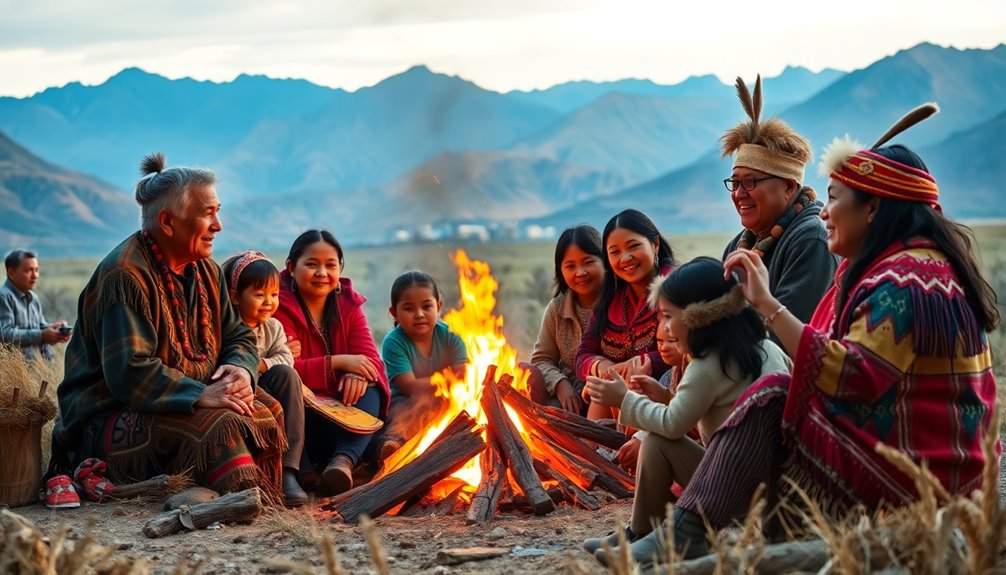
In foraging societies like the Shoshone, kinship ties are crucial for building strong community bonds. These connections shape social structures and promote cooperation, ensuring that resources are shared effectively.
The Shoshone community emphasizes bilateral kinship, recognizing both maternal and paternal relatives, which strengthens social networks and alliances. This egalitarian approach means that leadership roles often rotate based on individual expertise rather than fixed hierarchies.
Rituals and communal gatherings play a critical role in maintaining these kinship connections. They offer opportunities for social cohesion and cultural knowledge transmission.
Key aspects of kinship and community bonds include:
- Shared Resources: Families work together to gather food and share the bounty.
- Gift-Giving: This practice solidifies kinship bonds and establishes reciprocity among families.
- Social Cohesion: Rituals reinforce relationships and create a sense of belonging.
- Egalitarian Leadership: Skills dictate leadership roles, fostering respect and collaboration.
Through these elements, the Shoshone foster a rich tapestry of kinship and community bonds that are essential for their survival and cultural identity.
Adaptability to Environmental Changes

In a foraging society, you learn to assess resource availability constantly, adapting your strategies to seasonal changes.
By understanding migration patterns and the diverse food sources around you, your group can thrive in varying environments.
This adaptability not only sustains your community but also guarantees a resilient way of life.
Resource Availability Assessment
Resource availability assessment plays an essential role in the survival of foraging societies like the Shoshone. By understanding their environment, the Shoshone effectively adapt their subsistence strategies based on what resources are available throughout the year. This adaptability is key when facing environmental changes such as droughts or shifts in animal migration patterns.
To assess resource availability, the Shoshone utilize their extensive knowledge of local flora and fauna. They identify edible plants and animals and track their harvest times.
Here are some key aspects of this assessment:
- Diverse Resource Utilization: The Shoshone exploit a variety of food sources, including plants, small game, and fish.
- Ecological Mobility: Their nomadic lifestyle allows them to move between different ecological zones for better resource access.
- Flexible Social Structures: These structures enable equitable resource allocation, ensuring all community members have access to necessities.
- Resilience to Change: Their ability to adjust hunting and gathering practices showcases their resilience amid fluctuating environmental conditions.
Through these practices, the Shoshone demonstrate a profound understanding of resource availability, ensuring their survival and well-being.
Seasonal Migration Patterns
Throughout the year, the Shoshone people skillfully navigate their environment by following seasonal migration patterns that align with resource availability. You'd observe how they move between winter and summer camps, adapting their lifestyle to the changing seasons.
Their nomadic lifestyle allows them to travel in small family groups, reducing pressure on local resources and promoting sustainable foraging practices.
As temperatures shift and plant and animal populations fluctuate, the Shoshone adjust their migration routes to guarantee they're always near abundant resources. This adaptability is essential; it lets them thrive in diverse habitats, from cold mountainous regions in winter to warmer lowland areas in summer.
Knowledge passed down through generations helps them map these seasonal migrations, guaranteeing the community can effectively manage resources in response to environmental changes.
Diverse Food Sources
Adaptability is key for foraging societies like the Shoshone, who thrive on a diverse array of food sources. This diversity not only provides nutritional variety but also guarantees food security throughout the year.
The Shoshone tap into their extensive knowledge of local ecosystems, gathering over 100 different edible plants and utilizing various hunting and fishing techniques. By adapting their food sources to the environment, they can withstand seasonal changes and challenges such as droughts or resource depletion.
Here are some key aspects of how the Shoshone maintain their diverse food sources:
- Wild Plants: They gather a wide variety of edible flora, guaranteeing a balanced diet.
- Game: Seasonal hunting allows them to target specific animals during peak availability.
- Fish: Rivers and lakes provide a vital protein source, particularly in warmer months.
- Sustainable Practices: They employ harvesting techniques that preserve ecosystems for future generations.
This flexibility in food procurement enables the Shoshone to navigate their environment successfully, highlighting the importance of diversity in their survival strategy.
Rituals and Spiritual Beliefs
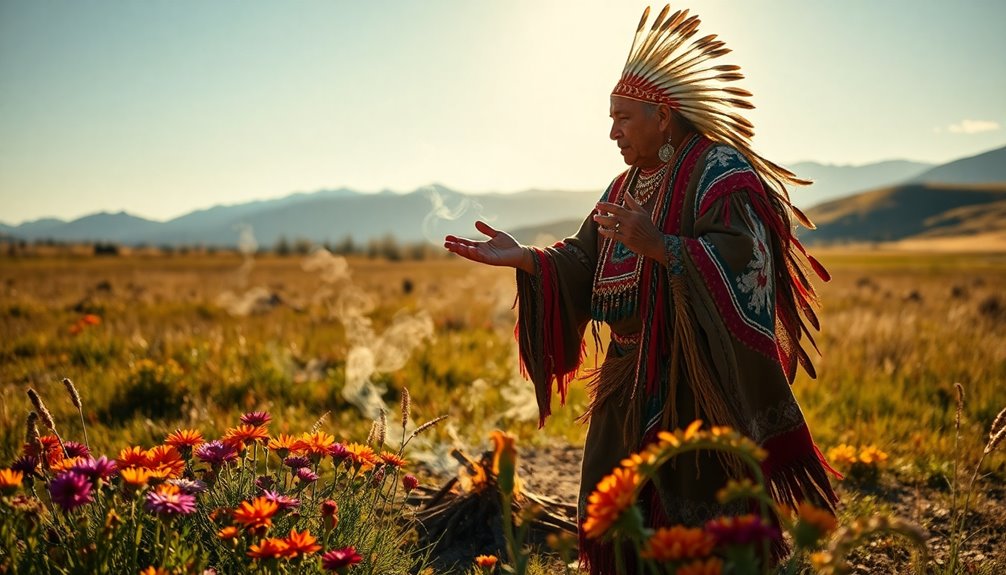
In a foraging society like the Shoshone, rituals and spiritual beliefs are deeply intertwined with nature and the cycles of life. You'll find that the Shoshone engage in various rituals that celebrate seasonal changes and the land's bounty. These communal gatherings and ceremonies reinforce traditions that highlight their connection to the earth.
The Shoshone worldview emphasizes the interconnectedness of all living beings, fostering a deep respect for nature and its resources.
Storytelling plays a crucial role in their spiritual practices, as oral traditions pass down knowledge and cultural values through generations. This practice not only preserves their identity but also strengthens community bonds.
Vision quests are another significant aspect of Shoshone spirituality, where individuals seek personal insight and guidance through solitude and reflection in nature.
Additionally, their spiritual beliefs find expression in art, music, and dance. These creative outlets are more than just cultural expressions; they serve as spiritual connections to their heritage and the natural world.
Through these rituals and spiritual practices, the Shoshone maintain a profound relationship with the environment and each other, celebrating life's interconnectedness in every aspect of their existence. This deep connection to nature often leads individuals to seek life-changing insights that foster personal growth and community resilience.
Resource Sharing and Cooperation
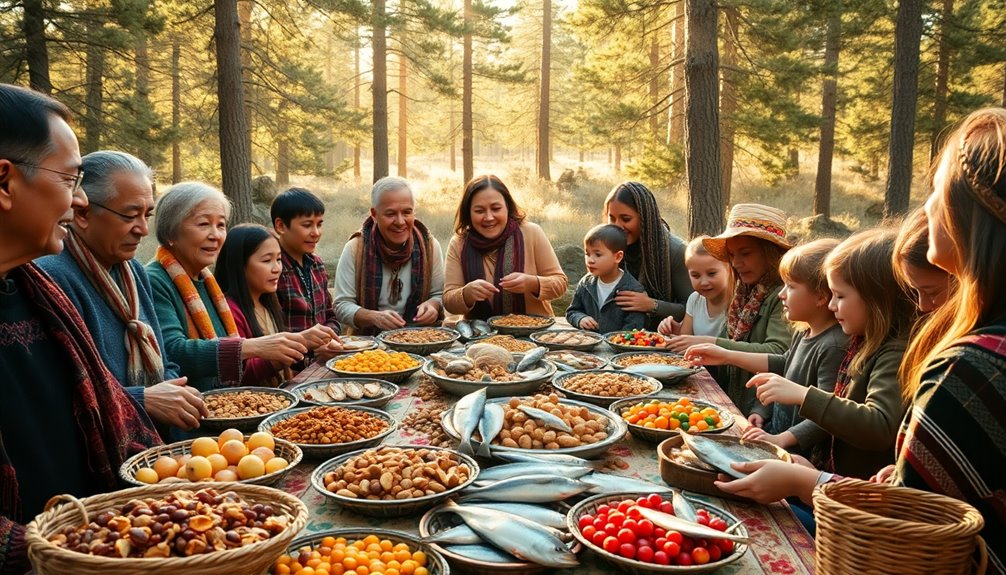
Rituals and spiritual beliefs in foraging societies not only strengthen community ties but also lay the groundwork for resource sharing and cooperation. In societies like the Shoshone, resource sharing is essential for survival. By distributing food and materials, community members guarantee everyone's well-being. This practice fosters social bonds, as individuals rely on each other's skills to gather diverse food sources.
Here's how cooperation manifests in these communities:
- Communal Hunting and Gathering: Groups work together to increase efficiency and success in acquiring resources.
- Cultural Significance: Sharing reinforces relationships and establishes trust among members.
- Reciprocity Principle: Individuals who contribute to resource gathering receive support during times of need.
- Community Resilience: Resource sharing promotes a sense of belonging and strengthens overall community stability.
Through these practices, the Shoshone highlight the importance of cooperation, which not only sustains individual needs but also cultivates a robust social fabric.
Impact of Seasonal Mobility

Seasonal mobility plays an important role in the survival and cultural practices of foraging societies like the Shoshone. By moving based on the availability of natural resources, you can effectively tap into diverse food sources throughout the year.
For instance, you might find yourself fishing in rivers during spring and hunting game in higher elevations during summer. This adaptability not only guarantees a varied diet but also enhances your understanding of the environment.
As you establish temporary camps in specific territories, you pass down essential knowledge about water, shelter, and seasonal food resources to younger generations. This connection to the land is significant for thriving in the challenging Great Basin environment.
Seasonal mobility also fosters social interactions with neighboring groups, promoting cultural exchange and trade. When you visit other territories, you share resources, ideas, and practices, strengthening community ties.
Modern Implications of Foraging Traits
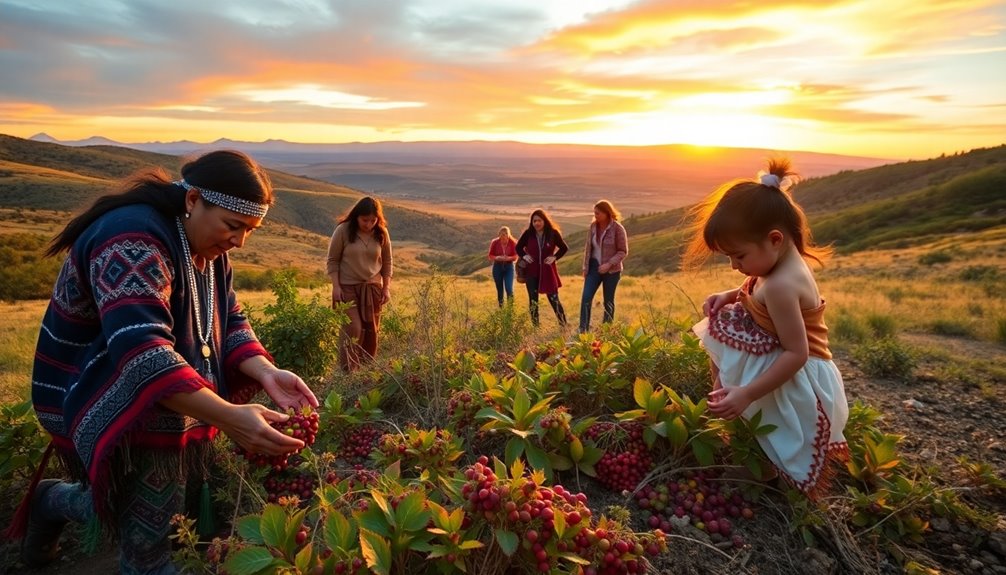
The knowledge and practices of foraging societies like the Shoshone offer valuable insights into modern sustainability efforts. By understanding their communalism and social structures, you can apply these principles to today's world to promote ecological balance.
Here are some key takeaways:
- Sustainable Practices: Foraging societies demonstrate how to harvest resources without depleting them, providing a model for modern sustainable living. This aligns with the concept of positive energy which can influence one's relationship with nature. Additionally, the importance of lower utility costs in tiny house living emphasizes efficiency in resource usage.
- Egalitarian Social Structures: The collective decision-making seen in these communities fosters cooperation, showing that resource sharing can lead to stronger, more resilient societies.
- Adaptability: Mobility in foraging groups teaches the importance of adapting to seasonal changes, a lesson that's essential in our rapidly changing environment.
- Community Bonds: The emphasis on communalism in foraging communities reinforces the value of social connections, reminding us that cooperation is crucial for survival.
- Mindful Consumption: Incorporating mindful art of decluttering practices can enhance our ability to appreciate resources and reduce waste.
Frequently Asked Questions
Which of the Following Are the Traits of a Foraging Society Such as the Shoshone?
When considering the traits of a foraging society like the Shoshone, you'll notice a strong reliance on hunting, gathering, and fishing for sustenance.
These groups often exhibit egalitarian social structures, with decisions made through consensus.
You'll see seasonal mobility as they move to access different resources, and a deep knowledge of their environment is essential for survival.
Additionally, communal sharing strengthens social ties and reinforces kinship within the group.
Which of the Following Is a Characteristic of Most Foraging Societies?
In the tapestry of human existence, foraging societies weave a vibrant thread characterized by mobility and adaptability.
You'll find that most foraging groups embrace a nomadic lifestyle, following the rhythms of nature to gather diverse food sources. This connection to the land fosters a profound understanding of their environment.
Furthermore, their social structures often reflect egalitarian values, where cooperation and kinship are the foundations of survival and community strength.
What Are the Two Basic Social Units of Traditional Foraging Societies?
In traditional foraging societies, you'll find two basic social units at play: the band and the nuclear family.
The band, typically made up of 20 to 50 individuals, operates as a cooperative group for hunting and gathering.
Within this band, the nuclear family—parents and their children—plays a vital role in domestic activities and child-rearing.
This kinship structure fosters strong relationships and communal sharing, essential for survival and resource management.
What Is Kinship in Society?
Kinship's key in connecting communities, creating bonds that build belonging. It's all about relationships—how you relate to others through blood, marriage, or adoption.
In different cultures, kinship systems shape social structures and inheritance, guiding your obligations and alliances. These ties often flourish through rituals, reinforcing connections that extend beyond biology.
Understanding this intricate web of kinship helps you grasp social dynamics and cultural practices within a community, enriching your perspective on human interactions.
Conclusion
In the tapestry of life, the Shoshone weave threads of cooperation, kinship, and respect for nature. Their foraging practices mirror a dance with the seasons, as they gather and share resources like a river flowing harmoniously through the landscape. Embracing their rituals and bonds, they remind us that survival isn't just about sustenance; it's about connection. As we navigate our modern world, we can learn from their wisdom, finding balance and community amid the chaos of daily life.

